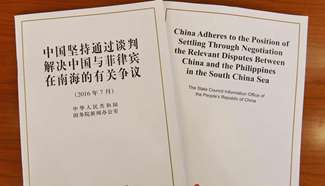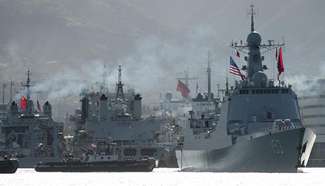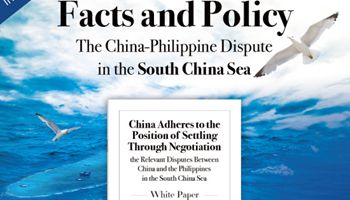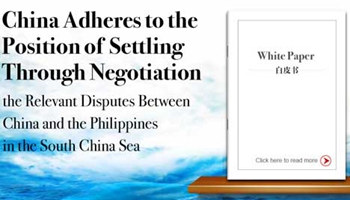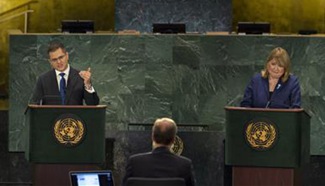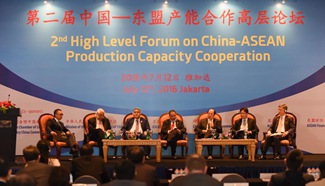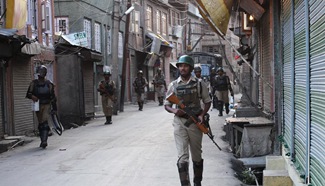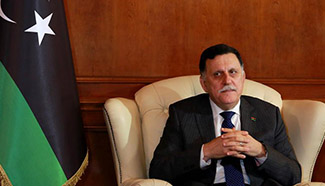SEOUL, July 13 (Xinhua) -- Experts here voiced serious concern about South Korea entering a U.S. missile defense network by deploying the Terminal High Altitude Area Defense (THAAD) to its soil, boosting expectations for escalating regional tensions and arms race amid strong oppositions from neighboring countries.
South Korea's defense ministry on Wednesday announced its agreement with the United States to deploy one THAAD battery to the Seongju county, some 300 km southeast of Seoul, by the end of next year.
The decision came amid repeated expression of resolute oppositions from China and Russia as the THAAD's X-band radar can keep watch on Chinese and Russian territories and negatively affect security interests of the neighbors.
Seoul claimed it will adopt the terminal mode radar with a detectable range of 600-800 km, but it can be converted at any time, and even takes less than a day to change, into a forward-based mode that can range as far as 2,000 km. The THAAD system will be operated by the U.S. Forces Korea (USFK).
"Pandora's box is opened," said Kim Joon Hyung, professor of international studies at Handong Global University. He said at a forum hosted by the People's Solidarity for Participatory Democracy (PSPD) that South Korea entered an irreversible U.S. missile defense network, incapable of slipping out of it once any country enters.
The United States has steadily materialized its Pivot-to-Asia strategy to expand its presence in the Asia-Pacific region. Last year, Washington revised its security guideline with Tokyo, enabling Japan to become a country capable of waging a war.
"Military cooperation between the U.S. and Japan will be completed if Japan revises its pacifist constitution. The last obstacle to the trilateral military alliance between South Korea and the two allies was removed with (South) Korea's decision to deploy the THAAD," said Kim.
The professor said strong oppositions from China and Russia came as the THAAD deployment means South Korea entering a part of the colossal U.S. missile defense network.
USFK commander Curtis Scaparrotti took issue with the need for the THAAD deployment for the first time in June 2014. Seoul had maintained a so-called "Three No" position, which means no request, no consultation and no decision on the U.S. missile defense deployment.
South Korea had adhered to developing its homegrown missile defense system, called the Korea Air and Missile Defense (KAMD), but President Park Geun-hye hinted at the deployment during her New Year's press conference in January, saying that the deployment would be reviewed according to whether it is in national interests.
On Feb. 7, when the Democratic People's Republic of Korea (DPRK) launched a long-range rocket, which was condemned as a disguised test of ballistic missile technology, Seoul and Washington announced a plan to launch discussion on whether to deploy the THAAD system.
Last Friday, the two allies decided to deploy it in South Korean soil, estimated to have been triggered by the DPRK's successful launch on June 22 of a Musudan intermediate-range ballistic missile that can reach U.S. military bases in Guam and Japan.
The THAAD system might be unable to intercept DPRK missiles targeting South Korea's territory as they travel at a much lower altitude that U.S. interceptors can destroy, according to experts, but Seoul decided to become a part of the U.S. missile defense network, depending on the traditional alliance with the United States that has never prevented the DPRK's nuclear and missile tests.
"It needs to bring up a question about a sort of myth that the U.S.-South Korea alliance can help ease tensions. The THAAD deployment will pose a serious threat to stability in Northeast Asia," said Lee Nam-ju, professor of Chinese Studies at Sungkonghoe University.
Lee said Seoul's compliance with Washington's strategy could bring risk factors to the Korean peninsula and the region. The professor said the deployment is an act to break a regional balance as the THAAD's radar can range Chinese and Russian territories.
"There's a myth spreading among the general public that the THAAD can defend against North Korea (DPRK)'s nuclear weapons," said Kim Yong Hyun, professor of North Korean studies at Dongguk University.
His comments indicated Seoul's military is misleading South Korean people lacking of military information to persuade them to think that their territory cannot be protected without the THAAD system. Kim said it was regrettable that the THAAD is regarded as a cure-all for the DPRK's nuclear and missile threats.
The professor said the THAAD deployment will benefit the United States the most, while South Korea will lose the most, noting that about 23,000 South Korean companies operating in China would be in trouble in the future due to the deployment decision. China is South Korea's largest trading partner.
Related:
S. Korea to deploy THAAD to southeastern region despite neighbors' opposition
SEOUL, July 13 (Xinhua) -- South Korea's defense ministry on Wednesday announced an agreement with the United States to deploy the U.S. missile defense system, called Terminal High Altitude Area Defense (THAAD), to its southeastern region despite continued opposition from neighboring countries.
One THAAD battery will be deployed to the Seongsan-ri region of the Seongju county in North Gyeongsang province, where South Korean Air Force's Hawk surface-to-air missile battery is located. Full story
DPRK warns of "physical measures" against U.S. deployment of THAAD in S.Korea
PYONGYANG, July 11 (Xinhua) -- The army of the Democratic People's Republic of Korea issued a warning Monday that it will take "physical measures" against the deployment of the Terminal High Altitude Area Defense (THAAD) in South Korea by the United States.
Seoul and Washington announced Friday the deployment of the THAAD as part of the U.S. Forces Korea (USFK) stationed in South Korea to better tackle the so-called nuclear and missile threats from the DPRK. Full story
News Analysis: S.Korea seeks to defend THAAD deployment despite oppositions at home, abroad
By Yoo Seungki
SEOUL, July 11 (Xinhua) -- South Korean government officials on Monday sought to tout the need for deploying the U.S. missile defense system, called Terminal High Altitude Area Defense (THAAD), in its territory despite oppositions and controversies at home and abroad.
President Park Geun-hye told a meeting with her senior advisors that the THAAD deployment would be a defensive measure to protect her country from the Democratic People's Republic of Korea (DPRK)'s nuclear and missile threats. Park said the U.S. interceptors will neither target any third-party nations nor infringe on security interests of any other country. Full story




